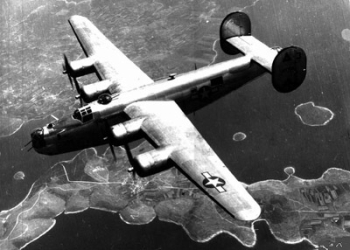
Publisher:
Bonnie King
CONTACT:
Newsroom@Salem-news.com
Advertising:
Adsales@Salem-news.com

~Truth~
~Justice~
~Peace~
TJP
Apr-09-2007 13:10

 TweetFollow @OregonNews
TweetFollow @OregonNews
Ten Missing WWII Airmen are Identified
Salem-News.comAmong dental records, other forensic identification tools and circumstantial evidence, scientists from the JPAC and the Armed Forces DNA Identification Laboratory also used mitochondrial DNA in the identification of the remains.
 B-24 Liberator during WWII Photo courtesy: globalair.com |
(MAROBE PROVINCE, New Guinea) - The Department of Defense POW/Missing Personnel Office announced today that the remains of ten U.S. servicemen, missing in action from World War II, have been identified and will be returned to their families for burial with full military honors.
They are 2nd Lt. Raymond A. Cooley, of Leary, Texas; 2nd Lt. Dudley R. Ives, of Ingleside, Texas; 2nd Lt. George E. Archer, of Cushing, Okla.; 2nd Lt. Donald F. Grady, of Harrisburg, Pa.; Tech. Sgt. Richard R. Sargent, of North Girard, Pa.; Tech. Sgt. Steve Zayac, of Cleveland, Ohio; Staff Sgt. Joseph M. King, of Detroit, Mich.; Staff Sgt. Thomas G. Knight, of Brookfield, Ill.; Staff Sgt. Norman L. Nell, of Tarkio, Mo.; and Staff Sgt. Blair W. Smith, of Nu Mine, Pa.; all U.S. Army Air Forces. The dates and locations of the funerals are being set by their families.
Representatives from the Army met with the next-of-kin of these men in their hometowns to explain the recovery and identification process and to coordinate interment with military honors on behalf of the secretary of the Army. On April 16, 1944, a B-24 Liberator crewed by these airmen was returning to the aerodrome at Nadzab, New Guinea, after bombing enemy targets near Hollandia. The aircraft was altering course due to bad weather and was proceeding to the aerodrome at Saidor, but it never returned to friendly lines.
In late 2001, the U.S. Embassy in Papua New Guinea notified the Joint POW/MIA Accounting Command that wreckage of a World War II bomber had been found in Morobe Province. Early the next year, a JPAC team surveyed the site and found aircraft wreckage and remains. They also collected more remains and Grady's identification tag from local villagers who had found the items at the crash site.
Later in 2002, a JPAC team began excavating the crash site and recovered remains and crew-related items, including identification tags for Knight and Smith. The team was unable to complete the recovery, and another JPAC team re-visited the site two weeks later to complete the excavation. The team found additional remains and identification tags for Sargent and King.
Among dental records, other forensic identification tools and circumstantial evidence, scientists from the JPAC and the Armed Forces DNA Identification Laboratory also used mitochondrial DNA in the identification of the remains.
Articles for April 8, 2007 | Articles for April 9, 2007 | Articles for April 10, 2007

Quick Links
DINING
Willamette UniversityGoudy Commons Cafe
Dine on the Queen
Willamette Queen Sternwheeler
MUST SEE SALEM
Oregon Capitol ToursCapitol History Gateway
Willamette River Ride
Willamette Queen Sternwheeler
Historic Home Tours:
Deepwood Museum
The Bush House
Gaiety Hollow Garden
AUCTIONS - APPRAISALS
Auction Masters & AppraisalsCONSTRUCTION SERVICES
Roofing and ContractingSheridan, Ore.
ONLINE SHOPPING
Special Occasion DressesAdvertise with Salem-News
Contact:AdSales@Salem-News.com

Salem-News.com:
googlec507860f6901db00.html

Terms of Service | Privacy Policy
All comments and messages are approved by people and self promotional links or unacceptable comments are denied.
Osotan; April 9, 2007 8:31 pm (Pacific time)
reminds me of the haunted ridggeline at B-17 crash site in Yuma. Is the S/Sgt. Joseph King listed a relative?.,and thanks for this article. I heard it here first!
[Return to Top]©2025 Salem-News.com. All opinions expressed in this article are those of the author and do not necessarily reflect those of Salem-News.com.